Understanding Employee vs Contractor and Redundancy in Law
VerifiedAdded on 2020/05/01
|10
|2052
|211
AI Summary
The assignment delves into the nuanced distinctions between employees and independent contractors within Australian law, highlighting the specific legal frameworks that govern their rights, responsibilities, and obligations. It examines key employment contracts, such as those in the hospitality industry, to illustrate how these distinctions manifest in real-world scenarios. Furthermore, it analyzes redundancy practices, referencing significant case laws like ACE Insurance Limited v Trifunovski and Australian Iron & Steel Pty Ltd v Banovic, which shed light on the application of 'last in first out' principles and their legal implications. The study underscores the importance of understanding these classifications to ensure compliance with employment laws and protect worker rights.

Running head: BUSINESS LAWS
Business Laws
Name of the student
Name of the university
Author note
Business Laws
Name of the student
Name of the university
Author note
Paraphrase This Document
Need a fresh take? Get an instant paraphrase of this document with our AI Paraphraser
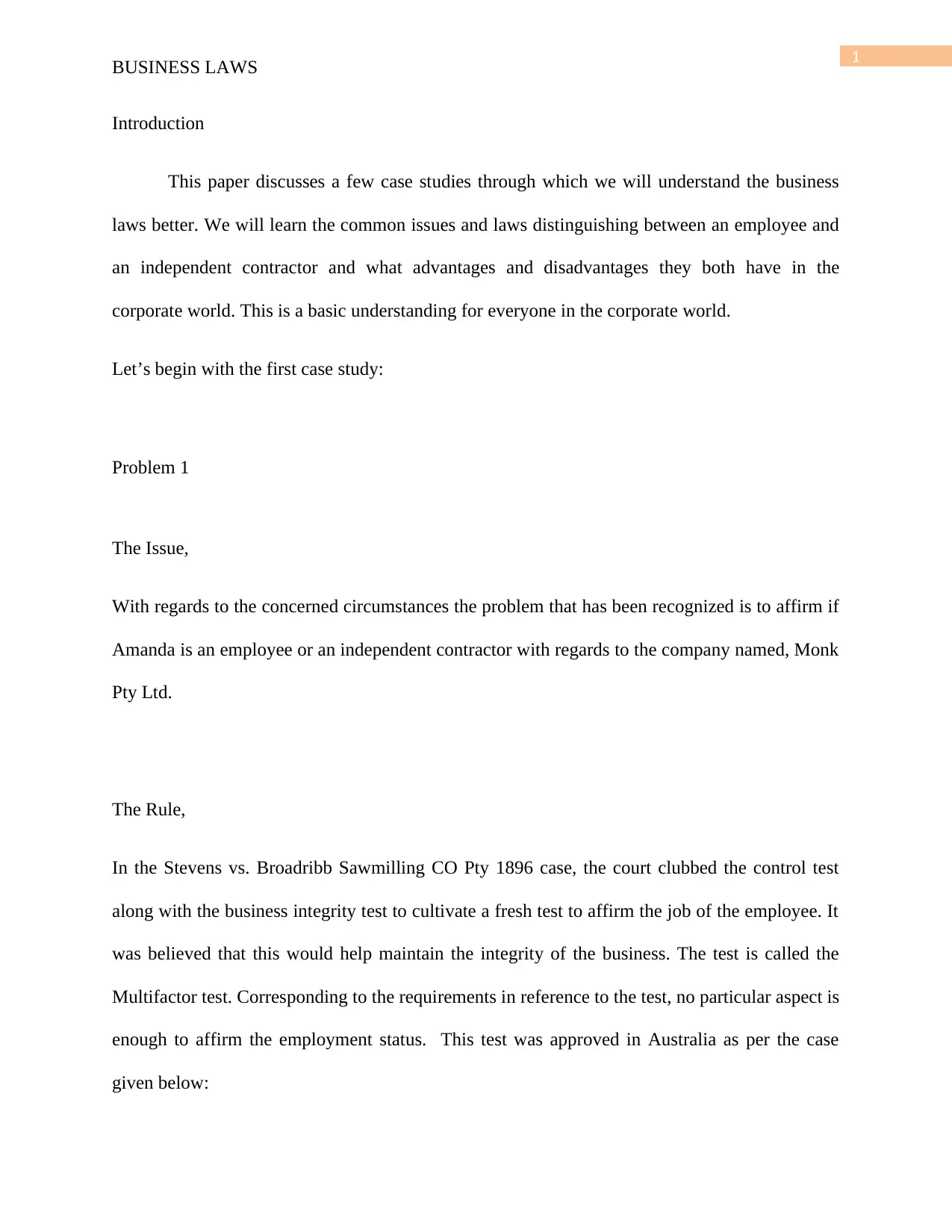
1
BUSINESS LAWS
Introduction
This paper discusses a few case studies through which we will understand the business
laws better. We will learn the common issues and laws distinguishing between an employee and
an independent contractor and what advantages and disadvantages they both have in the
corporate world. This is a basic understanding for everyone in the corporate world.
Let’s begin with the first case study:
Problem 1
The Issue,
With regards to the concerned circumstances the problem that has been recognized is to affirm if
Amanda is an employee or an independent contractor with regards to the company named, Monk
Pty Ltd.
The Rule,
In the Stevens vs. Broadribb Sawmilling CO Pty 1896 case, the court clubbed the control test
along with the business integrity test to cultivate a fresh test to affirm the job of the employee. It
was believed that this would help maintain the integrity of the business. The test is called the
Multifactor test. Corresponding to the requirements in reference to the test, no particular aspect is
enough to affirm the employment status. This test was approved in Australia as per the case
given below:
BUSINESS LAWS
Introduction
This paper discusses a few case studies through which we will understand the business
laws better. We will learn the common issues and laws distinguishing between an employee and
an independent contractor and what advantages and disadvantages they both have in the
corporate world. This is a basic understanding for everyone in the corporate world.
Let’s begin with the first case study:
Problem 1
The Issue,
With regards to the concerned circumstances the problem that has been recognized is to affirm if
Amanda is an employee or an independent contractor with regards to the company named, Monk
Pty Ltd.
The Rule,
In the Stevens vs. Broadribb Sawmilling CO Pty 1896 case, the court clubbed the control test
along with the business integrity test to cultivate a fresh test to affirm the job of the employee. It
was believed that this would help maintain the integrity of the business. The test is called the
Multifactor test. Corresponding to the requirements in reference to the test, no particular aspect is
enough to affirm the employment status. This test was approved in Australia as per the case
given below:
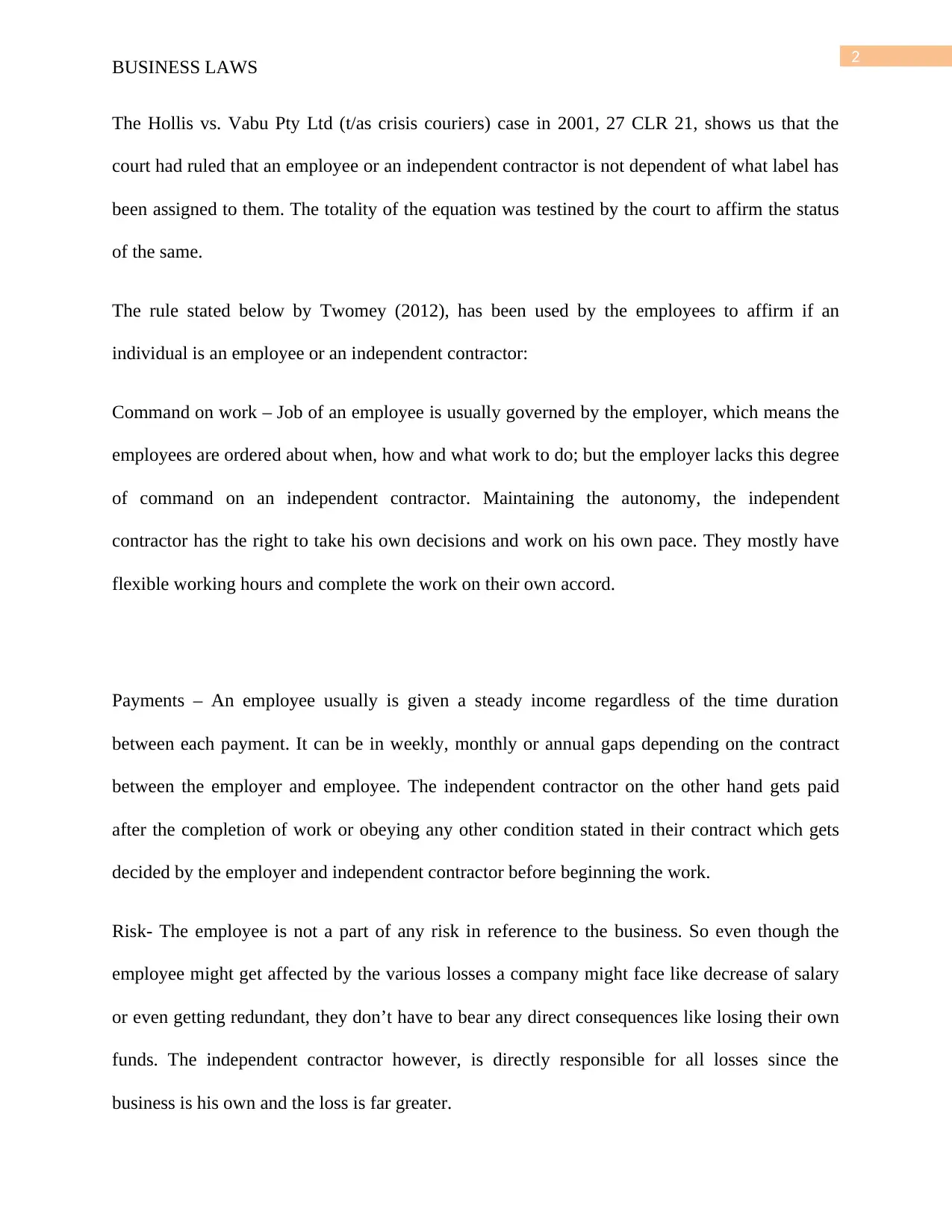
2
BUSINESS LAWS
The Hollis vs. Vabu Pty Ltd (t/as crisis couriers) case in 2001, 27 CLR 21, shows us that the
court had ruled that an employee or an independent contractor is not dependent of what label has
been assigned to them. The totality of the equation was testined by the court to affirm the status
of the same.
The rule stated below by Twomey (2012), has been used by the employees to affirm if an
individual is an employee or an independent contractor:
Command on work – Job of an employee is usually governed by the employer, which means the
employees are ordered about when, how and what work to do; but the employer lacks this degree
of command on an independent contractor. Maintaining the autonomy, the independent
contractor has the right to take his own decisions and work on his own pace. They mostly have
flexible working hours and complete the work on their own accord.
Payments – An employee usually is given a steady income regardless of the time duration
between each payment. It can be in weekly, monthly or annual gaps depending on the contract
between the employer and employee. The independent contractor on the other hand gets paid
after the completion of work or obeying any other condition stated in their contract which gets
decided by the employer and independent contractor before beginning the work.
Risk- The employee is not a part of any risk in reference to the business. So even though the
employee might get affected by the various losses a company might face like decrease of salary
or even getting redundant, they don’t have to bear any direct consequences like losing their own
funds. The independent contractor however, is directly responsible for all losses since the
business is his own and the loss is far greater.
BUSINESS LAWS
The Hollis vs. Vabu Pty Ltd (t/as crisis couriers) case in 2001, 27 CLR 21, shows us that the
court had ruled that an employee or an independent contractor is not dependent of what label has
been assigned to them. The totality of the equation was testined by the court to affirm the status
of the same.
The rule stated below by Twomey (2012), has been used by the employees to affirm if an
individual is an employee or an independent contractor:
Command on work – Job of an employee is usually governed by the employer, which means the
employees are ordered about when, how and what work to do; but the employer lacks this degree
of command on an independent contractor. Maintaining the autonomy, the independent
contractor has the right to take his own decisions and work on his own pace. They mostly have
flexible working hours and complete the work on their own accord.
Payments – An employee usually is given a steady income regardless of the time duration
between each payment. It can be in weekly, monthly or annual gaps depending on the contract
between the employer and employee. The independent contractor on the other hand gets paid
after the completion of work or obeying any other condition stated in their contract which gets
decided by the employer and independent contractor before beginning the work.
Risk- The employee is not a part of any risk in reference to the business. So even though the
employee might get affected by the various losses a company might face like decrease of salary
or even getting redundant, they don’t have to bear any direct consequences like losing their own
funds. The independent contractor however, is directly responsible for all losses since the
business is his own and the loss is far greater.
⊘ This is a preview!⊘
Do you want full access?
Subscribe today to unlock all pages.

Trusted by 1+ million students worldwide
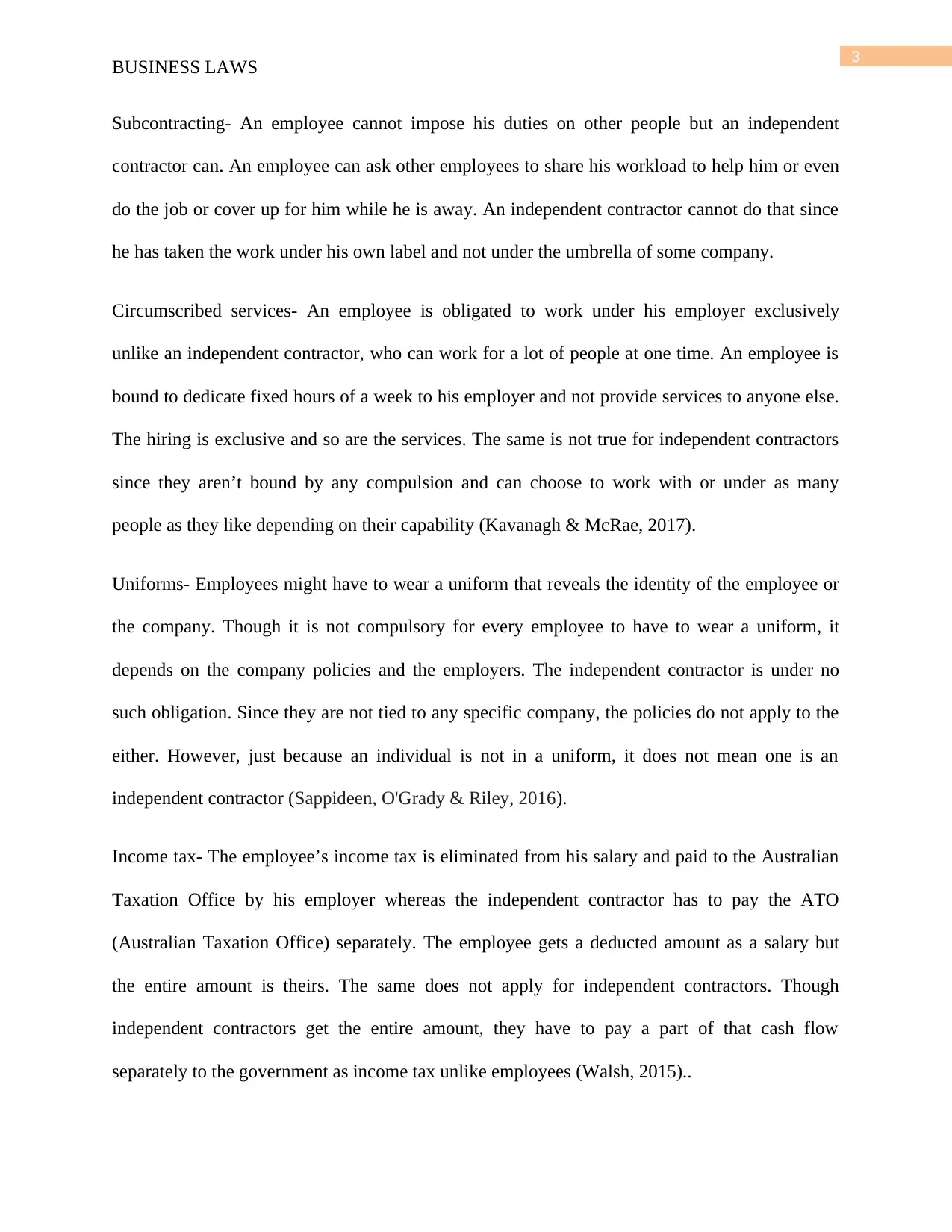
3
BUSINESS LAWS
Subcontracting- An employee cannot impose his duties on other people but an independent
contractor can. An employee can ask other employees to share his workload to help him or even
do the job or cover up for him while he is away. An independent contractor cannot do that since
he has taken the work under his own label and not under the umbrella of some company.
Circumscribed services- An employee is obligated to work under his employer exclusively
unlike an independent contractor, who can work for a lot of people at one time. An employee is
bound to dedicate fixed hours of a week to his employer and not provide services to anyone else.
The hiring is exclusive and so are the services. The same is not true for independent contractors
since they aren’t bound by any compulsion and can choose to work with or under as many
people as they like depending on their capability (Kavanagh & McRae, 2017).
Uniforms- Employees might have to wear a uniform that reveals the identity of the employee or
the company. Though it is not compulsory for every employee to have to wear a uniform, it
depends on the company policies and the employers. The independent contractor is under no
such obligation. Since they are not tied to any specific company, the policies do not apply to the
either. However, just because an individual is not in a uniform, it does not mean one is an
independent contractor (Sappideen, O'Grady & Riley, 2016).
Income tax- The employee’s income tax is eliminated from his salary and paid to the Australian
Taxation Office by his employer whereas the independent contractor has to pay the ATO
(Australian Taxation Office) separately. The employee gets a deducted amount as a salary but
the entire amount is theirs. The same does not apply for independent contractors. Though
independent contractors get the entire amount, they have to pay a part of that cash flow
separately to the government as income tax unlike employees (Walsh, 2015)..
BUSINESS LAWS
Subcontracting- An employee cannot impose his duties on other people but an independent
contractor can. An employee can ask other employees to share his workload to help him or even
do the job or cover up for him while he is away. An independent contractor cannot do that since
he has taken the work under his own label and not under the umbrella of some company.
Circumscribed services- An employee is obligated to work under his employer exclusively
unlike an independent contractor, who can work for a lot of people at one time. An employee is
bound to dedicate fixed hours of a week to his employer and not provide services to anyone else.
The hiring is exclusive and so are the services. The same is not true for independent contractors
since they aren’t bound by any compulsion and can choose to work with or under as many
people as they like depending on their capability (Kavanagh & McRae, 2017).
Uniforms- Employees might have to wear a uniform that reveals the identity of the employee or
the company. Though it is not compulsory for every employee to have to wear a uniform, it
depends on the company policies and the employers. The independent contractor is under no
such obligation. Since they are not tied to any specific company, the policies do not apply to the
either. However, just because an individual is not in a uniform, it does not mean one is an
independent contractor (Sappideen, O'Grady & Riley, 2016).
Income tax- The employee’s income tax is eliminated from his salary and paid to the Australian
Taxation Office by his employer whereas the independent contractor has to pay the ATO
(Australian Taxation Office) separately. The employee gets a deducted amount as a salary but
the entire amount is theirs. The same does not apply for independent contractors. Though
independent contractors get the entire amount, they have to pay a part of that cash flow
separately to the government as income tax unlike employees (Walsh, 2015)..
Paraphrase This Document
Need a fresh take? Get an instant paraphrase of this document with our AI Paraphraser
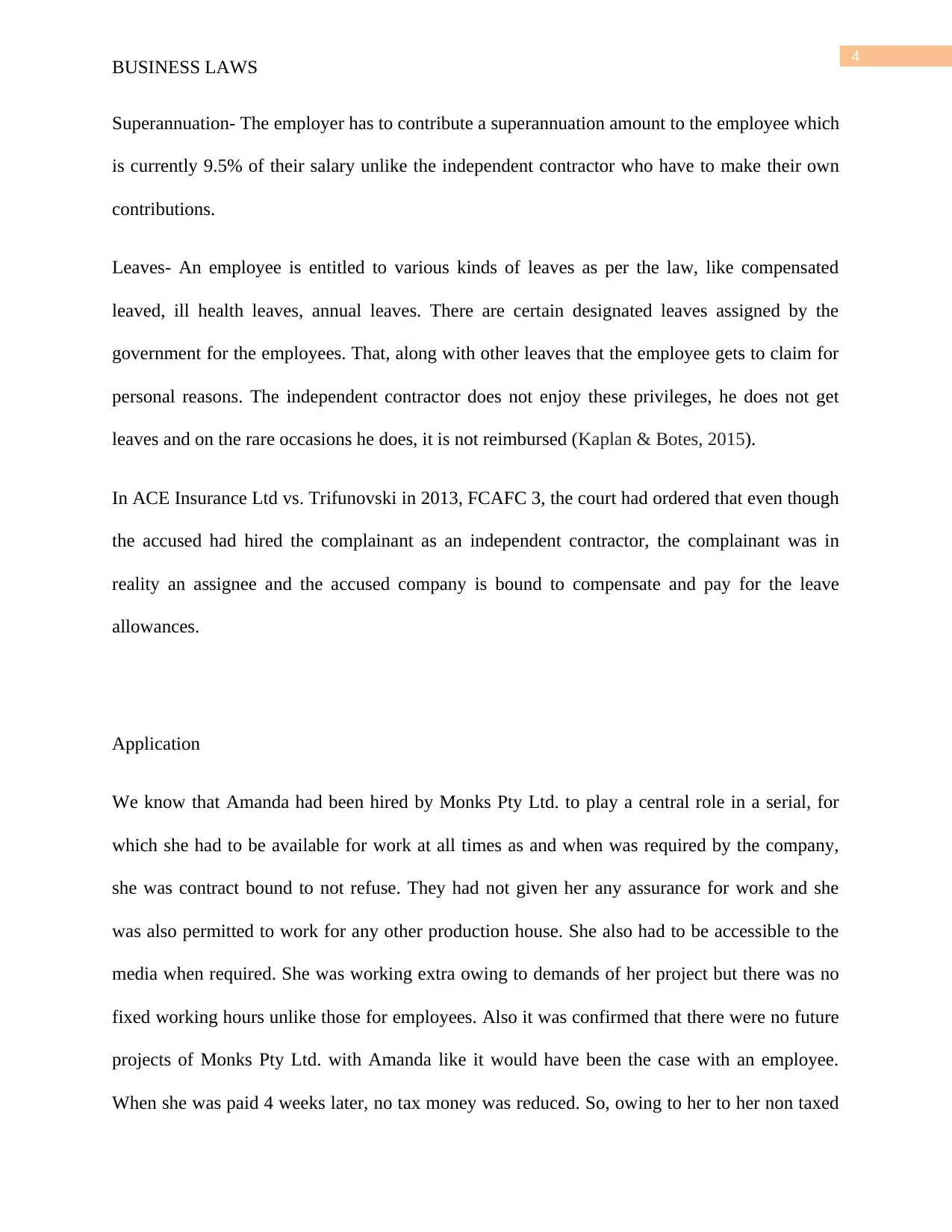
4
BUSINESS LAWS
Superannuation- The employer has to contribute a superannuation amount to the employee which
is currently 9.5% of their salary unlike the independent contractor who have to make their own
contributions.
Leaves- An employee is entitled to various kinds of leaves as per the law, like compensated
leaved, ill health leaves, annual leaves. There are certain designated leaves assigned by the
government for the employees. That, along with other leaves that the employee gets to claim for
personal reasons. The independent contractor does not enjoy these privileges, he does not get
leaves and on the rare occasions he does, it is not reimbursed (Kaplan & Botes, 2015).
In ACE Insurance Ltd vs. Trifunovski in 2013, FCAFC 3, the court had ordered that even though
the accused had hired the complainant as an independent contractor, the complainant was in
reality an assignee and the accused company is bound to compensate and pay for the leave
allowances.
Application
We know that Amanda had been hired by Monks Pty Ltd. to play a central role in a serial, for
which she had to be available for work at all times as and when was required by the company,
she was contract bound to not refuse. They had not given her any assurance for work and she
was also permitted to work for any other production house. She also had to be accessible to the
media when required. She was working extra owing to demands of her project but there was no
fixed working hours unlike those for employees. Also it was confirmed that there were no future
projects of Monks Pty Ltd. with Amanda like it would have been the case with an employee.
When she was paid 4 weeks later, no tax money was reduced. So, owing to her to her non taxed
BUSINESS LAWS
Superannuation- The employer has to contribute a superannuation amount to the employee which
is currently 9.5% of their salary unlike the independent contractor who have to make their own
contributions.
Leaves- An employee is entitled to various kinds of leaves as per the law, like compensated
leaved, ill health leaves, annual leaves. There are certain designated leaves assigned by the
government for the employees. That, along with other leaves that the employee gets to claim for
personal reasons. The independent contractor does not enjoy these privileges, he does not get
leaves and on the rare occasions he does, it is not reimbursed (Kaplan & Botes, 2015).
In ACE Insurance Ltd vs. Trifunovski in 2013, FCAFC 3, the court had ordered that even though
the accused had hired the complainant as an independent contractor, the complainant was in
reality an assignee and the accused company is bound to compensate and pay for the leave
allowances.
Application
We know that Amanda had been hired by Monks Pty Ltd. to play a central role in a serial, for
which she had to be available for work at all times as and when was required by the company,
she was contract bound to not refuse. They had not given her any assurance for work and she
was also permitted to work for any other production house. She also had to be accessible to the
media when required. She was working extra owing to demands of her project but there was no
fixed working hours unlike those for employees. Also it was confirmed that there were no future
projects of Monks Pty Ltd. with Amanda like it would have been the case with an employee.
When she was paid 4 weeks later, no tax money was reduced. So, owing to her to her non taxed
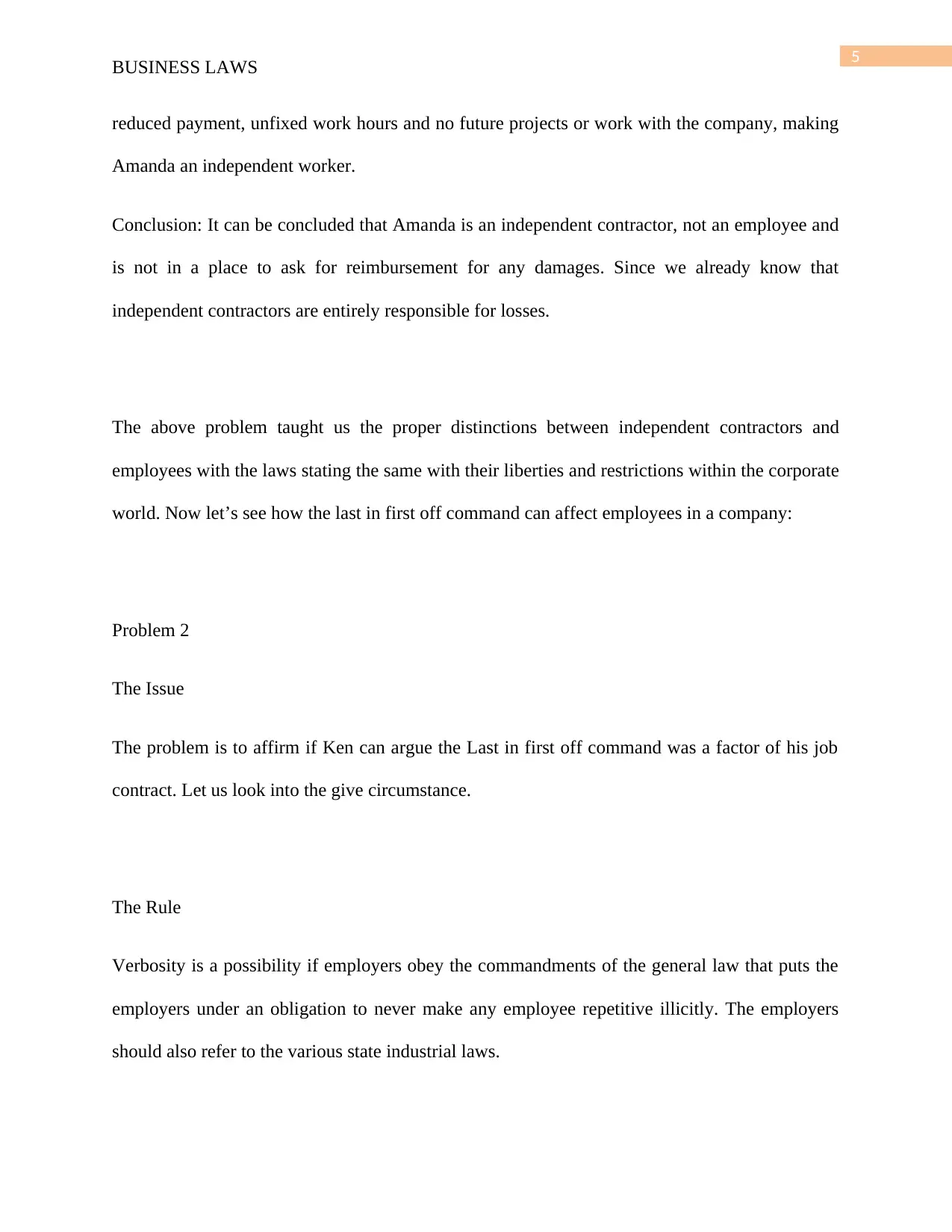
5
BUSINESS LAWS
reduced payment, unfixed work hours and no future projects or work with the company, making
Amanda an independent worker.
Conclusion: It can be concluded that Amanda is an independent contractor, not an employee and
is not in a place to ask for reimbursement for any damages. Since we already know that
independent contractors are entirely responsible for losses.
The above problem taught us the proper distinctions between independent contractors and
employees with the laws stating the same with their liberties and restrictions within the corporate
world. Now let’s see how the last in first off command can affect employees in a company:
Problem 2
The Issue
The problem is to affirm if Ken can argue the Last in first off command was a factor of his job
contract. Let us look into the give circumstance.
The Rule
Verbosity is a possibility if employers obey the commandments of the general law that puts the
employers under an obligation to never make any employee repetitive illicitly. The employers
should also refer to the various state industrial laws.
BUSINESS LAWS
reduced payment, unfixed work hours and no future projects or work with the company, making
Amanda an independent worker.
Conclusion: It can be concluded that Amanda is an independent contractor, not an employee and
is not in a place to ask for reimbursement for any damages. Since we already know that
independent contractors are entirely responsible for losses.
The above problem taught us the proper distinctions between independent contractors and
employees with the laws stating the same with their liberties and restrictions within the corporate
world. Now let’s see how the last in first off command can affect employees in a company:
Problem 2
The Issue
The problem is to affirm if Ken can argue the Last in first off command was a factor of his job
contract. Let us look into the give circumstance.
The Rule
Verbosity is a possibility if employers obey the commandments of the general law that puts the
employers under an obligation to never make any employee repetitive illicitly. The employers
should also refer to the various state industrial laws.
⊘ This is a preview!⊘
Do you want full access?
Subscribe today to unlock all pages.

Trusted by 1+ million students worldwide
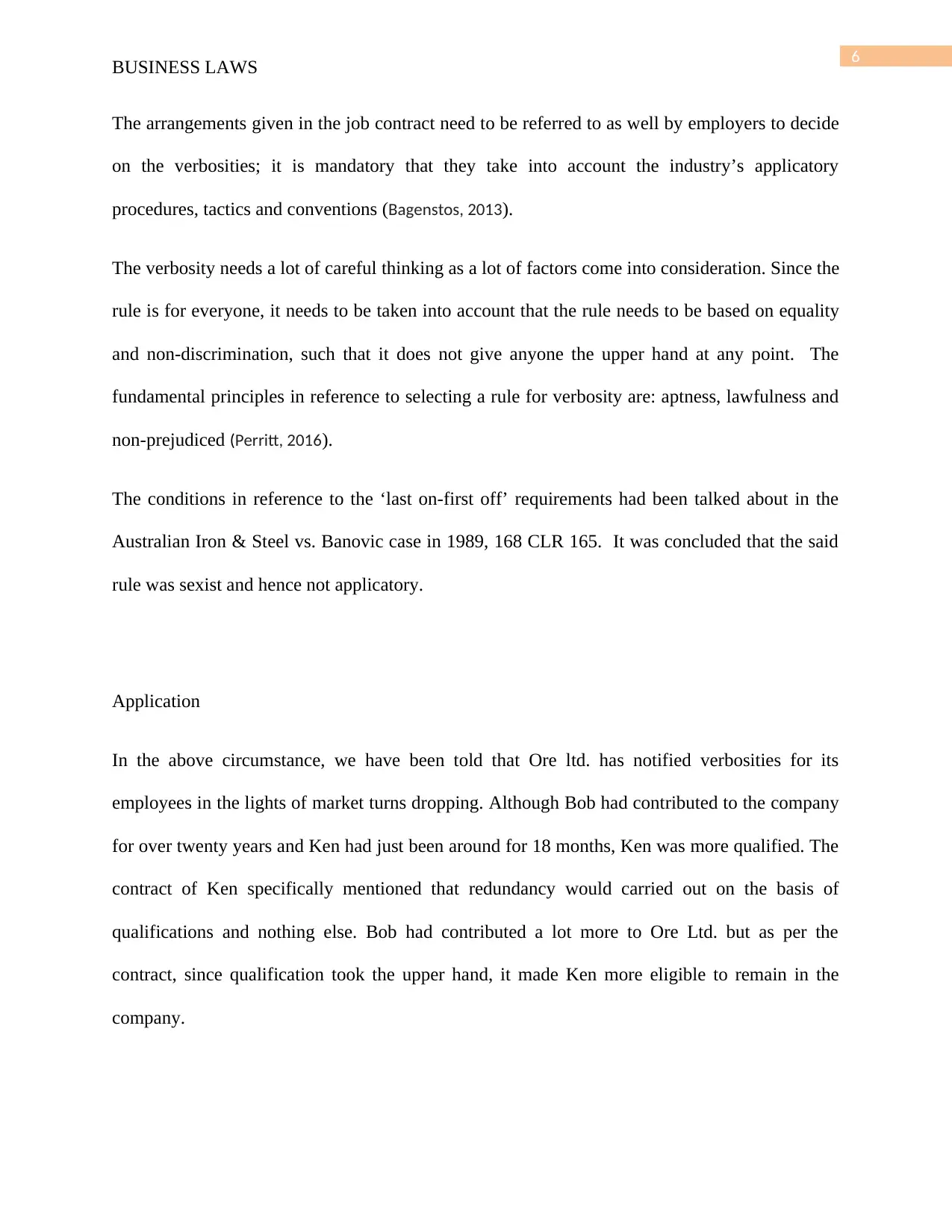
6
BUSINESS LAWS
The arrangements given in the job contract need to be referred to as well by employers to decide
on the verbosities; it is mandatory that they take into account the industry’s applicatory
procedures, tactics and conventions (Bagenstos, 2013).
The verbosity needs a lot of careful thinking as a lot of factors come into consideration. Since the
rule is for everyone, it needs to be taken into account that the rule needs to be based on equality
and non-discrimination, such that it does not give anyone the upper hand at any point. The
fundamental principles in reference to selecting a rule for verbosity are: aptness, lawfulness and
non-prejudiced (Perritt, 2016).
The conditions in reference to the ‘last on-first off’ requirements had been talked about in the
Australian Iron & Steel vs. Banovic case in 1989, 168 CLR 165. It was concluded that the said
rule was sexist and hence not applicatory.
Application
In the above circumstance, we have been told that Ore ltd. has notified verbosities for its
employees in the lights of market turns dropping. Although Bob had contributed to the company
for over twenty years and Ken had just been around for 18 months, Ken was more qualified. The
contract of Ken specifically mentioned that redundancy would carried out on the basis of
qualifications and nothing else. Bob had contributed a lot more to Ore Ltd. but as per the
contract, since qualification took the upper hand, it made Ken more eligible to remain in the
company.
BUSINESS LAWS
The arrangements given in the job contract need to be referred to as well by employers to decide
on the verbosities; it is mandatory that they take into account the industry’s applicatory
procedures, tactics and conventions (Bagenstos, 2013).
The verbosity needs a lot of careful thinking as a lot of factors come into consideration. Since the
rule is for everyone, it needs to be taken into account that the rule needs to be based on equality
and non-discrimination, such that it does not give anyone the upper hand at any point. The
fundamental principles in reference to selecting a rule for verbosity are: aptness, lawfulness and
non-prejudiced (Perritt, 2016).
The conditions in reference to the ‘last on-first off’ requirements had been talked about in the
Australian Iron & Steel vs. Banovic case in 1989, 168 CLR 165. It was concluded that the said
rule was sexist and hence not applicatory.
Application
In the above circumstance, we have been told that Ore ltd. has notified verbosities for its
employees in the lights of market turns dropping. Although Bob had contributed to the company
for over twenty years and Ken had just been around for 18 months, Ken was more qualified. The
contract of Ken specifically mentioned that redundancy would carried out on the basis of
qualifications and nothing else. Bob had contributed a lot more to Ore Ltd. but as per the
contract, since qualification took the upper hand, it made Ken more eligible to remain in the
company.
Paraphrase This Document
Need a fresh take? Get an instant paraphrase of this document with our AI Paraphraser

7
BUSINESS LAWS
Conclusion: Since selecting people on the basis qualifications was a criteria but last on/first off
wasn’t, there is not grounds based on which Bob should remain. The contract favours Ken, so
Ken should not be a verbosity.
BUSINESS LAWS
Conclusion: Since selecting people on the basis qualifications was a criteria but last on/first off
wasn’t, there is not grounds based on which Bob should remain. The contract favours Ken, so
Ken should not be a verbosity.
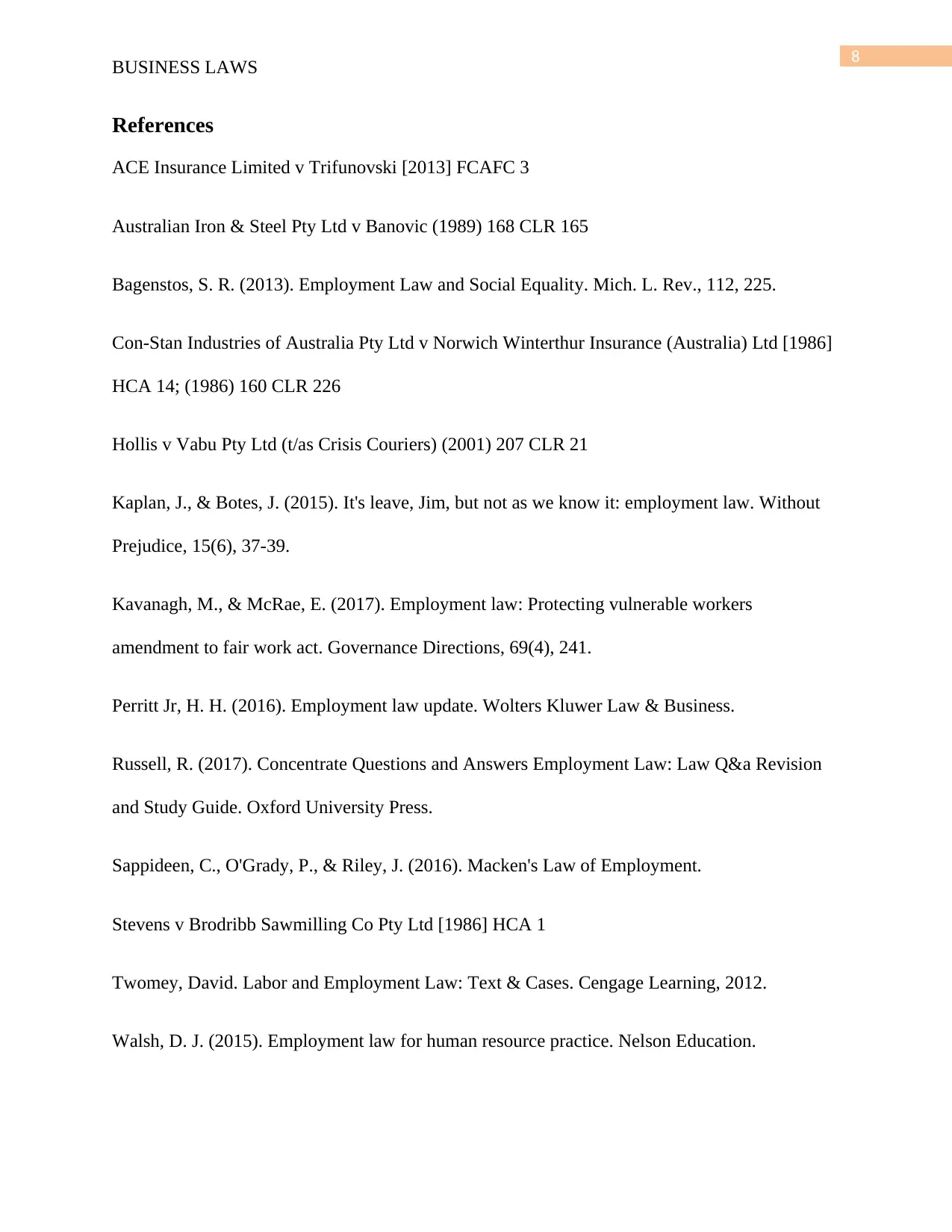
8
BUSINESS LAWS
References
ACE Insurance Limited v Trifunovski [2013] FCAFC 3
Australian Iron & Steel Pty Ltd v Banovic (1989) 168 CLR 165
Bagenstos, S. R. (2013). Employment Law and Social Equality. Mich. L. Rev., 112, 225.
Con-Stan Industries of Australia Pty Ltd v Norwich Winterthur Insurance (Australia) Ltd [1986]
HCA 14; (1986) 160 CLR 226
Hollis v Vabu Pty Ltd (t/as Crisis Couriers) (2001) 207 CLR 21
Kaplan, J., & Botes, J. (2015). It's leave, Jim, but not as we know it: employment law. Without
Prejudice, 15(6), 37-39.
Kavanagh, M., & McRae, E. (2017). Employment law: Protecting vulnerable workers
amendment to fair work act. Governance Directions, 69(4), 241.
Perritt Jr, H. H. (2016). Employment law update. Wolters Kluwer Law & Business.
Russell, R. (2017). Concentrate Questions and Answers Employment Law: Law Q&a Revision
and Study Guide. Oxford University Press.
Sappideen, C., O'Grady, P., & Riley, J. (2016). Macken's Law of Employment.
Stevens v Brodribb Sawmilling Co Pty Ltd [1986] HCA 1
Twomey, David. Labor and Employment Law: Text & Cases. Cengage Learning, 2012.
Walsh, D. J. (2015). Employment law for human resource practice. Nelson Education.
BUSINESS LAWS
References
ACE Insurance Limited v Trifunovski [2013] FCAFC 3
Australian Iron & Steel Pty Ltd v Banovic (1989) 168 CLR 165
Bagenstos, S. R. (2013). Employment Law and Social Equality. Mich. L. Rev., 112, 225.
Con-Stan Industries of Australia Pty Ltd v Norwich Winterthur Insurance (Australia) Ltd [1986]
HCA 14; (1986) 160 CLR 226
Hollis v Vabu Pty Ltd (t/as Crisis Couriers) (2001) 207 CLR 21
Kaplan, J., & Botes, J. (2015). It's leave, Jim, but not as we know it: employment law. Without
Prejudice, 15(6), 37-39.
Kavanagh, M., & McRae, E. (2017). Employment law: Protecting vulnerable workers
amendment to fair work act. Governance Directions, 69(4), 241.
Perritt Jr, H. H. (2016). Employment law update. Wolters Kluwer Law & Business.
Russell, R. (2017). Concentrate Questions and Answers Employment Law: Law Q&a Revision
and Study Guide. Oxford University Press.
Sappideen, C., O'Grady, P., & Riley, J. (2016). Macken's Law of Employment.
Stevens v Brodribb Sawmilling Co Pty Ltd [1986] HCA 1
Twomey, David. Labor and Employment Law: Text & Cases. Cengage Learning, 2012.
Walsh, D. J. (2015). Employment law for human resource practice. Nelson Education.
⊘ This is a preview!⊘
Do you want full access?
Subscribe today to unlock all pages.

Trusted by 1+ million students worldwide

9
BUSINESS LAWS
BUSINESS LAWS
1 out of 10
Related Documents
Your All-in-One AI-Powered Toolkit for Academic Success.
+13062052269
info@desklib.com
Available 24*7 on WhatsApp / Email
![[object Object]](/_next/static/media/star-bottom.7253800d.svg)
Unlock your academic potential
Copyright © 2020–2025 A2Z Services. All Rights Reserved. Developed and managed by ZUCOL.





